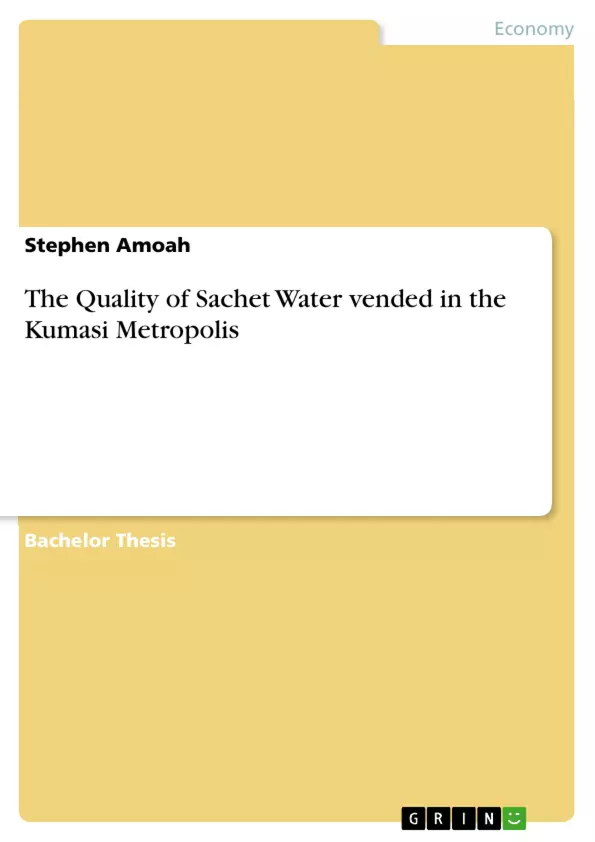The use of sachet water has become an important primary source of drinking water, but little is known about bacteriological quality and improvements to quality control. The report examines bacteriological indicators for 10 sachet water samples from some communities in Kumasi, Ghana. It was conducted in some areas in the Kumasi metropolis, Ghana to examine the suitability of packaged water for consumption by evaluating their bacteriological, physical and chemical characteristics. These were total coliform, faecal coliform, pH, conductivity, total dissolved solids, nitrate, sulphate, chloride, phosphate, total alkalinity, flourides, sodium total hardness, calcium and magnesium hardness and their ions. Standard methods were used for the sample analysis.
Table of Contents
- Chapter One: Introduction
- Problem Statement
- Justification
- General Objectives
- Specific Objectives
- Chapter Two: Literature Review
- The Global need for clean water
- The importance of quality water
- Sachet water in Ghana
- Typically packaged water production process
- Packaged water contamination
- Physico-chemical parameters
- pH
- Conductivity
- Total dissolved solids
- Total hardness
- Alkalinity
- Phosphate
- Sulphate
Objectives and Key Themes
This thesis aims to assess the bacteriological quality of sachet water sold in the Kumasi Metropolis, Ghana. The study investigates the suitability of this water for consumption by analyzing its bacteriological, physical, and chemical characteristics. This includes evaluating several parameters to determine whether the water meets established standards.
- Bacteriological quality of sachet water
- Physical and chemical characteristics of sachet water
- Compliance with WHO standards
- Assessment of water safety in the Kumasi Metropolis
- Public health implications of sachet water consumption
Chapter Summaries
Chapter One: Introduction: This chapter introduces the research topic, highlighting the widespread use of sachet water as a primary drinking water source in the Kumasi Metropolis. It establishes the problem statement by emphasizing the lack of knowledge regarding the bacteriological quality and quality control of this water. The chapter then justifies the need for the study, outlining its general and specific objectives. The specific objectives detail the parameters to be analyzed— bacteriological indicators, physical characteristics, and chemical components—to determine the water's suitability for consumption. The overall goal is to contribute to a better understanding of the safety and quality of sachet water in the region, impacting public health decisions.
Chapter Two: Literature Review: This chapter provides a comprehensive overview of existing research on water quality and its relevance to the study's context. It begins by discussing the global need for clean water and the importance of maintaining its quality for human health. The review specifically addresses the use and production of sachet water in Ghana, including typical production processes and potential sources of contamination. A significant portion is dedicated to detailing various physico-chemical parameters that will be assessed— pH, conductivity, total dissolved solids, total hardness, alkalinity, phosphate, and sulphate— explaining their importance in determining water quality and linking them to established standards. This chapter sets the theoretical framework and context for the methodology and results presented in subsequent chapters (not included in this preview).
Keywords
Sachet water, water quality, bacteriological analysis, physico-chemical parameters, Kumasi Metropolis, Ghana, public health, WHO standards, drinking water safety, water contamination.
Frequently Asked Questions: A Comprehensive Language Preview of Sachet Water Quality in Kumasi, Ghana
What is the main topic of this research?
This research assesses the bacteriological quality of sachet water sold in the Kumasi Metropolis, Ghana, analyzing its suitability for consumption by examining bacteriological, physical, and chemical characteristics. It aims to determine if this water meets established standards and its implications for public health.
What are the key objectives of the study?
The study aims to evaluate the bacteriological quality of sachet water, analyze its physical and chemical characteristics, assess its compliance with WHO standards, and ultimately determine the safety of sachet water in the Kumasi Metropolis and its impact on public health.
What specific parameters are being analyzed in the study?
The research analyzes various bacteriological indicators, along with several physico-chemical parameters including pH, conductivity, total dissolved solids, total hardness, alkalinity, phosphate, and sulphate. These parameters help determine the water's suitability for consumption.
What is covered in the literature review?
The literature review covers the global need for clean water, the importance of water quality, the use and production of sachet water in Ghana, typical production processes, potential sources of contamination, and detailed explanations of the physico-chemical parameters being assessed, linking them to established standards.
What is the scope of the study in terms of location?
The study focuses specifically on the Kumasi Metropolis in Ghana.
What is the significance of this study?
The study contributes to a better understanding of the safety and quality of sachet water in Kumasi, informing public health decisions and potentially improving water safety in the region.
What are the key chapters of the research?
The research includes an introduction establishing the problem, justification, objectives, and a literature review providing background information on water quality and sachet water production. Further chapters (not included in this preview) likely detail the methodology, results, and discussion.
What are the key words associated with this research?
Key words include: Sachet water, water quality, bacteriological analysis, physico-chemical parameters, Kumasi Metropolis, Ghana, public health, WHO standards, drinking water safety, water contamination.
What is the overall goal of this research?
The overarching goal is to assess the safety and quality of sachet water in Kumasi, Ghana, with the ultimate aim of contributing to improved public health outcomes.
- Quote paper
- Stephen Amoah (Author), 2016, The Quality of Sachet Water vended in the Kumasi Metropolis, Munich, GRIN Verlag, https://www.grin.com/document/1150227



